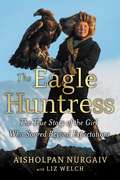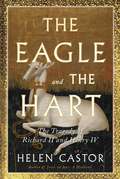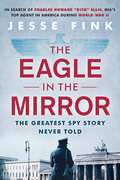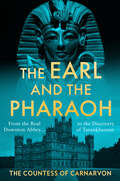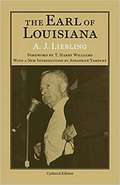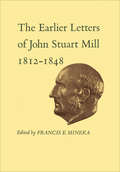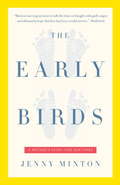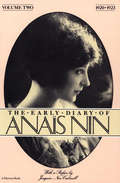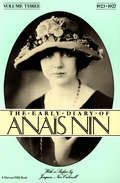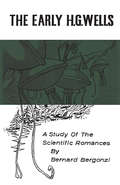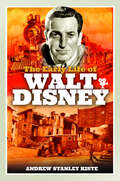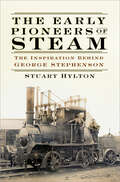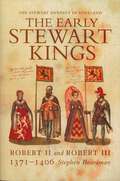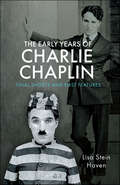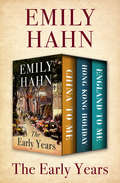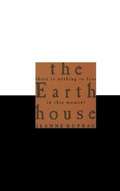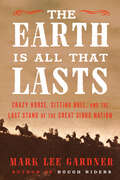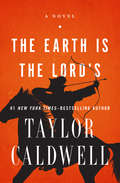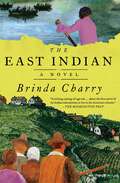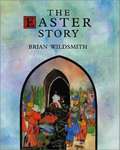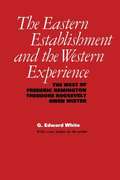- Table View
- List View
The Eagle Huntress: The True Story of the Girl Who Soared Beyond Expectations
by Aisholpan NurgaivThe subject of the award-winning documentary The Eagle Huntress tells the true story of how she became the first girl to compete in -- and win -- one of Mongolia's most prestigious competitions.In this compelling memoir, teenaged eagle hunter Aisholpan Nurgaiv tells her own story for the first time, speaking directly with award-winning and New York Times bestselling author Liz Welch (I Will Always Write Back), who traveled to Mongolia for this book. Nurgaiv's story and fresh, sincere voice are not only inspiring but truly magnificent: with the support of her father, she captured and trained her own golden eagle and won the Ölgii eagle festival. She was the only girl to compete in the festival.Filled with stunning photographs, The Eagle Huntress is a striking tale of determination -- of a girl who defied expectations and achieved what others declared impossible. Aisholpan Nurgaiv's story is both unique and universally relatable: a memoir of survival, empowerment, and the positive impact of one person's triumph.
The Eagle and the Hart: The Tragedy of Richard II and Henry IV
by Helen CastorFrom an acclaimed historian and author comes an epic history: the dual biography of Richard II and Henry IV, two cousins whose lives played out in extraordinary parallel, until Henry deposed the tyrant Richard and declared himself King of England.Richard of Bordeaux and Henry of Bolingbroke, cousins born just three months apart, were ten years old when Richard became king of England. They were thirty-two when Henry deposed him and became king in his place. Now, the story behind one of the strangest and most fateful events in English history (and the inspiration behind Shakespeare&’s most celebrated history plays) is brought to vivid life by the acclaimed author of Blood and Roses, Helen Castor. Richard had birthright on his side, and a profound belief in his own God-given majesty. But beyond that, he lacked all qualities of leadership. A narcissist who did not understand or accept the principles that underpinned his rule, he was neither a warrior defending his kingdom, nor a lawgiver whose justice protected his people. Instead, he declared that &“his laws were in his own mouth,&” and acted accordingly. He sought to define as treason any resistance to his will and recruited a private army loyal to himself rather than the realm—and he intended to destroy those who tried to restrain him. Henry was everything Richard was not: a leader who inspired both loyalty and friendship, a soldier and a chivalric hero, dutiful, responsible, principled. After years of tension and conflict, Richard banished him and seized his vast inheritance. Richard had been crowned a king but he had become a tyrant, and as a tyrant—ruling by arbitrary will rather than established law—he was deposed by his cousin Henry, the only possible candidate to take his place. Henry was welcomed as a liberator, a champion of the people against his predecessor&’s paranoid despotism. But within months he too was facing rebellion. Men knew that a deposer could in turn be deposed, and the new king found himself buffeted by unrest and by chronic ill-health until he seemed a shadow of his former self, trapped by political uncertainty and troubled by these signs that God might not, after all, endorse his actions. Captivating, immersive, and highly relevant to today&’s times, The Eagle and the Hart is a story about what happens when a ruler prioritizes power over the interests of his own people. When a ruler demands loyalty to himself as an individual, rather than duty to the established constitution, and when he seeks to reshape reality rather than concede the force of verifiable truths. Above all, it is a story about how a nation was brought to the brink of catastrophe and disintegration—and, in the end, how it was brought back.
The Eagle in the Mirror
by Jesse FinkPart biography, part forensic jigsaw puzzle, part cold-case detective investigation, The Eagle in the Mirror is the astonishing untold story of Charles Howard &“Dick&” Ellis, the Australian-born British intelligence officer and master spy accused by some espionage experts of being the traitor of the century. The longest serving spy for the Secret Intelligence Service (MI6), Ellis came to New York at the beginning of World War II as deputy to William Stephenson at British Security Coordination (BSC) and helped set up for William Donovan the Office of Strategic Services (OSS), what would eventually evolve into the Central Intelligence Agency (CIA). At one point in the 1940s he was considered one of the top three secret agents in MI6, controlling its activities &“for half the world.&” Ellis allegedly received prior warning of the Japanese attack on Pearl Harbor and, through the conduit of Stephenson, relayed that warning to President Franklin D. Roosevelt. After World War II, Ellis was awarded the Legion of Merit by President Harry S. Truman. But in the 1980s espionage writer Chapman Pincher and retired Security Service (MI5) intelligence officer Peter Wright posthumously accused Ellis of having operated as a &“triple agent&” for Nazi Germany and the Soviet Union. In 1965, while under interrogation in London, Ellis had allegedly made a confession that he had supplied information to the Nazis prior to the war. The scope of Ellis&’s purported betrayal was considered even worse than notorious British traitor and double agent Kim Philby, who defected to the Soviet Union in 1963. However, Pincher&’s and Wright&’s accusations against Ellis have never been comprehensively proven. Was Ellis guilty or was an innocent man framed? Did he take the fall for someone else? Or had the intelligence agencies of the United States, the United Kingdom and Australia been fatally compromised by a &“super-mole&”? Jesse Fink unravels a gripping real-life international whodunit in this long-overdue biography of the unheralded Dick Ellis, one of the most consequential figures in modern history.
The Eagles of Heart Mountain: A True Story of Football, Incarceration, and Resistance in World War II America
by Bradford PearsonThe impeccably researched, deeply moving, never-before-told tale about a World War II incarceration camp in Wyoming and its extraordinary high school football team—for fans of The Boys in the Boat and The Storm on Our Shores. In the spring of 1942, the United States government forced 120,000 Japanese Americans from their homes in California, Oregon, Washington, and Arizona and sent them to incarceration camps across the West. Nearly 14,000 of them landed on the outskirts of Cody, Wyoming, at the base of Heart Mountain. Behind barbed wire fences, they faced racism, cruelty, and frozen winters. Trying to recreate comforts from home, many established Buddhist temples and sumo wrestling pits. Kabuki performances drew hundreds of spectators—yet there was little hope. That is, until the fall of 1943, when the camp&’s high school football team, the Eagles, started its first season and finished it undefeated, crushing the competition from nearby, predominantly white high schools. Amid all this excitement, American politics continued to disrupt their lives as the federal government drafted men from the camps for the front lines—including some of the Eagles. As the team&’s second season kicked off, the young men faced a choice to either join the Army or resist the draft. Teammates were divided, and some were jailed for their decisions. The Eagles of Heart Mountain honors the resilience of extraordinary heroes and the power of sports in a sweeping and inspirational portrait of one of the darkest moments in American history.
The Earl and the Pharaoh: From the Real Downton Abbey to the Discovery of Tutankhamun
by The Countess of CarnarvonBestselling author the Countess of Carnarvon tells the thrilling behind-the-scenes story of the discovery of the tomb of Tutankhamun on its centennial, and explores the unparalleled life of family ancestor George Herbert—the famed Egyptologist, world-traveler, and 5th Earl of Carnarvon behind it—whose country house, Highclere Castle, is the setting of the beloved series Downton Abbey.In November 1922, the world was mesmerized by news of an astonishing historical find in Egypt’s legendary Valley of Kings: the discovery of the tomb of the Egyptian Pharoah Tutankhamun. George Herbert, himself a famed amateur Egyptologist and noted antiquities collector, financed the expedition and excavation headed by lead archaeologist Howard Carter, and accompanied him inside this sacred space that had remained untouched for centuries.Inside the tomb, the explorers found King Tut’s sarcophagus and a treasure trove of astonishing artifacts: chariots and model boats, board games and paintings, a coffin made of pure gold. But these objects were more than just beautifully crafted works of art; they shed new light on Tutankhamun world and this fabled period of history, and changed our understanding of how the ancient Egyptians had lived—transforming overnight what had been formed through centuries of history and myth.Drawing on Highclere Castle’s archives, the Countess of Carnarvon pays homage to her ancestor on the 100th anniversary of this extraordinary event. In vivid and dramatic detail, she brings into focus the larger-than-life characters and lustrous settings—as well as those twists of luck and tragedies that shaped Herbert’s life. Across the early 1900s, Highclere saw no less drama than the fictional Downton Abbey, with early tragedies for the Earl and love affairs, as well highs of exorbitant wealth and trials of punishing debt. But above all there was adventure. While Herbert first went to Egypt for his health, this mysterious, romantic land would become a second home; the beloved place where he funneled his attentions over a period of decades, never quite realizing how great the fruits of his labors would prove.The Earl and the Pharaoh features two 2 8-page full-color photo inserts.
The Earl of Louisiana
by Jonathan Yardley A. J. Liebling T. Harry WilliamsIn the summer of 1959, A. J. Liebling, veteran writer for the New Yorker, came to Louisiana to cover a series of bizarre events that began with Governor Earl K. Long's commitment to a mental institution. Captivated by his subject, Liebling remained to write the fascinating yet tragic story of Uncle Earl's final year in politics. First published in 1961, The Earl of Louisiana recreates a stormy era in Louisiana politics and captures the style and personality of one of the most colorful and paradoxical figures in the state's history. This updated edition of the book includes a foreword by T. Harry Williams, Pulitzer Prize-winning author of Huey Long: A Biography, and a new introduction by Pulitzer Prize-winning critic Jonathan Yardley that discusses Liebling's career and his most famous book from a twenty-first-century perspective.
The Earlier Letters of John Stuart Mill 1812-1848: Volumes XII-XIII
by John Stuart Mill Francis MinekaThese volumes of Mill's letters have been awaited eagerly by all scholars in the field of nineteenth-century studies. They inaugurate most auspiciously the edition of the Collected Works of John Stuart Mill planned and directed by an editorial committee appointed from the Faculty of Arts and Science of the University of Toronto and from the University of Toronto Press. In this collection of 537 letters and excerpts of letters are included all the personal letters available. It contains 238 hitherto unpublished letters and 72 letters with previously unpublished passages. Letters previously published have been recollated whenever possible. All are meticulously edited and annotated.
The Early Birds: A Mother's Story for Our Times
by Jenny MintonIn the winter of 2002, Jenny Minton delivered twin boys. She was thirty-one weeks pregnant, and her boys, conceived through in vitro fertilization, were more than two months early. Both boys were placed on immediate life support, and for sixty-four days they hovered, critically ill, in the neonatal intensive care unit of a New York City hospital. The Early Birds is a record of their time there and the story of Minton's harrowing, triumphant quest to bring her sons home. With impeccable restraint, in sharp, unforgettable scenes, Minton takes readers into the heart of an experience that is both singular and with a significant increase in twin births over the last twenty years, and a commensurate rise in premature births increasingly common. She reflects with piercing candor on her persistent, often heartbreaking reckoning with her own guilt, and the inadequacy she feels for not having carried her boys to term. She examines how little she knew, and how little information doctors provided, as she entered the largely unregulated realm of assisted reproduction. She confronts her decision not to go back to work, and the overwhelming sensation that life has swept her away. She offers moving interrogations of science and fate, and the role of providence in conception. And she describes the glorious triumphs of ordinary life, even as she wrestles with the unanswerable questions that remain. A fiercely intelligent, closely observed, powerfully gripping narrative about conception and childbirth, and a poignant and provocative journey into motherhood in an age of modern medicine, told with precision and indelible grace.
The Early Diary of Anaïs Nin, 1920–1923: 1920–1923 (The Early Diaries of Anaïs Nin #2)
by Anaïs NinThe diarist&’s account of her life in the early 1920s explores &“the conflict she felt between artistic longings and her pre-ordained female fate&” (The Detroit News). Continuing the journey of self-education and self-discovery she began in Linotte, Anaïs Nin discloses a part of her life that had previously remained private. She discusses the period in which she met Hugo Guiler, the young man who later became her husband, and made the wrenching transition from the shelter of her family to the world of artists and models. She also reveals the struggle she faced between her expected role as a woman and her determination to be a writer—a negotiation that still poses difficulties for many of us almost a century after Nin wrote this diary. &“Through sheer nerve, confidence, and will, Nin made of the everyday something magical. This was a gift, indeed, and it&’s a fascinating process to witness.&” —The Christian Science Monitor With a preface by Joaquin Nin-Culmell
The Early Diary of Anaïs Nin, 1923–1927: 1923–1927 (The Early Diaries of Anaïs Nin #3)
by Anaïs NinA revealing look at the life of this &“extraordinary and unconventional writer&” during the mid-1920s (The New York Times Book Review). In this volume of her earlier series of personal diaries, Anaïs Nin tells how she exorcised the obsession that threatened her marriage—and nearly drove her to suicide. &“Through sheer nerve, confidence, and will, Nin made of the everyday something magical. This was a gift, indeed, and it&’s a fascinating process to witness.&” —The Christian Science Monitor With an editor&’s note by Rupert Pole and a preface by Joaquin Nin-Culmell
The Early H.G.Wells: A Study of the Scientific Romances
by Bernard BergonziThis is a sensitive study of Wells' imaginative development during his formative years. It comes at a time when interest in H.G. Wells' early writing is beginning to revive, owing, no doubt, to the current translation into reality of some aspects of science fiction.Mr. Bergonzi examines Wells' early fiction, from surviving student writings of the late eighties to 1901 when he published The First Men in the Moon, his last significant scientific romance, and Anticipations, his first systematic non-fictional treatise. The main emphasis of his study falls on the scientific romances of the nineties, which are examined in detail. In addition to literary analysis, relevant source material and reviews, which show how contemporaries received Wells' work, are noted.Wells' early attitude to science is shown to have been deeply ambivalent, as is apparent in his successive uses of the Frankenstein archetype. His intellectual attitudes tended towards scepticism and pessimism rather than to the 'utopian' optimism associated with his later career.These romances reflect in imaginative and non-discursive form some of the major preoccupations of late-Victorian England: the impact of Darwinism, of Socialism, and an increasing lack of national self-confidence. Mr. Bergonzi sees Wells as essentially a fin de siècle myth-maker, and he argues that it is this aspect of Wells' work which most requires attention if he is to be remembered in the future. Two early pieces by Wells, now unobtainable elsewhere, are given in an Appendix. One, The Chronic Argonauts, a fragment of a fantastic novel written at the age of 21, is the earliest draft of The Time Machine.
The Early Life of Walt Disney
by Andrew Stanley KisteThe Origins of Walt Disney tells the story of the famous artist and entertainer in a fresh way, placing him in the cultural narrative of twentieth century America and the world.Most biographies of Walt Disney portray him as a creative genius who revolutionized the entertainment industry during the first half of the twentieth century. While he did transform the medium of animation, quickly becoming a household name during his late thirties, many biographies tell the story of Walt Disney’s development in a historical vacuum, separate from the historical events happening around him. However, while Walt Disney was certainly a history-influencer, historical events happening in America and the world also shaped the entertainment pioneer he would become. As the twentieth century began, a new form of entertainment, “motion pictures,” would emerge, capturing the imagination of a young boy from Missouri. Over the next several years, Walt Disney would begin to hone his art skills, overcoming a number of hurdles including numerous relocations, a brutal paper route, a deployment to Europe in the days after World War One, numerous bankruptcies, and even homelessness. It was these adversities, along with the historical events that surrounded him, that would influence the man he would become. For the first time ever, The Early Life of Walt Disney tells some important stories that help to flesh out the Disney history. How instrumental was Elias Disney’s career as a carpenter in Chicago? Why did the Disneys really leave Chicago to move to Marceline, Missouri? What types of jobs did Walt perform in France in the days following World War One? How was Walt influenced by the budding industry of animation in America? In addition to answering these questions, The Origins of Walt Disney also includes a tour of the newly restored Walt Disney Birthplace, a new museum located in the childhood home of Walt Disney in Chicago, Illinois!
The Early Pioneers of Steam: The Inspiration Behind George Stephenson
by Stuart HyltonWe think of the Stephensons and Brunel as the fathers of the railways, and their Liverpool and Manchester and Great Western Railways as the prototypes of the modern systems. But who were the railways’ grandfathers and great-grandfathers? The rapid evolution of the railways after 1830 depended on the juggernauts of steam locomotion being able to draw upon centuries of experience in using and developing railways, and of harnessing the power of steam. Giants the Stephensons and others may have been, but they stood upon the foundations built by many other considerable – if lesser-known – talents. This is the story of those early pioneers of steam.
The Early Poetry of Robert Graves: The Goddess Beckons
by Kersnowski Frank L.Like many men of his generation, poet Robert Graves was indelibly marked by his experience of trench warfare in World War I. The horrific battles in which he fought and his guilt over surviving when so many perished left Graves shell-shocked and disoriented, desperately seeking a way to bridge the rupture between his conventional upbringing and the uncertainties of postwar British society. In this study of Graves's early poetry, Frank Kersnowski explores how his war neurosis opened a door into the unconscious for Graves and led him to reject the essential components of the Western idea of reality—reason and predictability. In particular, Kersnowski traces the emergence in Graves's early poems of a figure he later called "The White Goddess," a being at once terrifying and glorious, who sustains life and inspires poetry. Drawing on interviews with Graves's family, as well as unpublished correspondence and drafts of poems, Kersnowski argues that Graves actually experienced the White Goddess as a real being and that his life as a poet was driven by the purpose of celebrating and explaining this deity and her matriarchy.
The Early Stewart Kings: Robert II and Robert III 1371–1406 (The\stewart Dynasty In Scotland Ser.)
by Stephen BoardmanThe Stewart Dynasty in Scotland series aims to bring the rich political heritage of late medieval and early modern Scotland before as wide a reading public as possible, with specialist authors writing for the general reader as well as the student or academic. This volume is number one in the series and is also the first scholarly biography of the two kings who established medieval Scotland’s most famous and durable royal dynasty. Robert II, long regarded as a weak and ineffective king, pursued a determined political and propaganda campaign which largely overcame initial political opposition. Robert III was forced to engage in a long-term struggle with his brother Albany for control of the kingdom. Firmly based on contemporary documentary sources, Stephen Boardman's study examines the ways in which the unjustly poor reputations of both kings grew from later embellishments to contemporary political propaganda.
The Early Years of Charlie Chaplin: Final Shorts and First Features
by Lisa Stein HavenA thorough look into the early life and career of Charlie Chaplin. Charlie Chaplin’s career has been described, critiqued, and scrutinized. There are book-length studies on Chaplin’s music hall career, his career at Keystone Studios and the Mutual Studios. Somehow, his tenure with First National studios, however, has been largely neglected, even though it was during this several-year contractual time period that Chaplin built and occupied his own studio for the first time, that he attempted and succeeded in filming a comedy feature (The Kid) and that he helped to set up United Artists, an organization that protected the salaries and creative freedom of actors in Hollywood. This period in Chaplin’s story is especially interesting because such landmark moments are accompanied by Chaplin’s first marriage and divorce, the death of his first child, his friendship with French silent film comedian Max Linder, World War I and the role he would play in it, and the production and release of several unsuccessful films that marked Chaplin’s first creative blockage - one that threatened his future career. This book will discuss the transitional periods just before and after the First National contract, as well as the all-important period satisfying it. Archival evidence provides most of the support for the book’s assertions, from the Chaplin archive (property of Roy Export, digitized by Cineteca di Bologna, Italy), and the personal archives of other individuals or institutions discussed. Rare photos will illustrate the story.
The Early Years: China to Me, Hong Kong Holiday, and England to Me
by Emily HahnMemoirs of an exotic, unconventional life in Asia and Great Britain in the 1930s and 1940s, from a colorful, prolific New Yorker writer ahead of her time. China to Me: A proud feminist and fearless traveler, Emily Hahn set out for China in 1935 and stayed through the early years of the Second Sino-Japanese War, wandering, carousing, living, loving—and writing. During her travels from Nanjing to Shanghai, Chongqing, and Hong Kong, where she lived through the Japanese invasion in 1941, Hahn embarks upon an affair with lauded Chinese poet Shao Xunmei; gets a pet gibbon and names him Mr. Mills; establishes a close bond with the women who would become the subjects of her bestselling book The Soong Sisters; battles an acquired addiction to opium; and has a child with Charles Boxer, a married British intelligence officer. Deemed scandalous at the time of its publication in 1944, Hahn&’s now classic memoir remains remarkable for her insights into a tumultuous period and frankness about her personal exploits. &“The keen prose is suffused with an intellectual freedom and freshness of perspective that vivify the concerns of a long-gone world.&” —Publishers Weekly Hong Kong Holiday: The same day they attacked Pearl Harbor, the Japanese invaded the British colony of Hong Kong, which they would occupy until their surrender in 1945. Emily Hahn was living there with her newborn daughter. The baby&’s father, Charles Boxer, the local head of British army intelligence, was imprisoned in a POW camp. With sharp observations and incisive wit, Hahn gives a vivid picture of her time in the oppressed city—from daily life in the bazaars, beauty shops, restaurants, and opium dens to the crowded hospitals and internment camps—until she fled the city in 1943 with her daughter. England to Me: Following the end of the Second World War, Hahn married Charles Boxer—fortunately reports of his beheading by the Japanese had been greatly exaggerated—and they returned to his inherited estate in the English countryside. From Southampton to London, Hahn offers a fascinating portrait of a postwar country in flux, as well as her own struggles to adjust to a more sedate English country life after her harrowing but exciting years in the Far East.
The Earth House
by Jeanne DuprauTwo women in the midst of busy suburban lives, one a dental hygienist, the other, a technical writer, visit a Zen center "out of curiosity and some vague inclination to find something deeper than our everyday experience." As these Western women encounter Eastern spirituality, they begin to develop a new life plan--centered on building a house in the Sierras--and life begins a new plan for them. Soon, the course of nature and humanity will collide, converge, and compromise in two lives transformed by pain and patience. Jeanne DuPrau gives us a powerful lesson in listening, loving, and letting go.
The Earth Is All That Lasts: Crazy Horse, Sitting Bull, and the Last Stand of the Great Sioux Nation
by Mark Lee Gardner"Fast-paced and highly absorbing." —Wall Street JournalA magisterial new history of the fierce final chapter of the "Indian Wars," told through the lives of the two most legendary and consequential American Indian leaders, who led Sioux resistance and triumphed at the Battle of Little BighornTrue West magazine's "Best Nonfiction Book of the Year" Winner of the Colorado Book AwardCrazy Horse and Sitting Bull: Their names are iconic, their significance in American history undeniable. Together, these two Lakota chiefs, one a fabled warrior and the other a revered holy man, crushed George Armstrong Custer’s vaunted Seventh Cavalry. Yet their legendary victory at the Little Big Horn has overshadowed the rest of their rich and complex lives. Now, based on years of research and drawing on a wealth of previously ignored primary sources, award-winning author Mark Lee Gardner delivers the definitive chronicle, thrillingly told, of these extraordinary Indigenous leaders.Both Crazy Horse and Sitting Bull were born and grew to manhood on the High Plains of the American West, in an era when vast herds of buffalo covered the earth, and when their nomadic people could move freely, following the buffalo and lording their fighting prowess over rival Indian nations. But as idyllic as this life seemed to be, neither man had known a time without whites. Fur traders and government explorers were the first to penetrate Sioux lands, but they were soon followed by a flood of white intruders: Oregon-California Trail travelers, gold seekers, railroad men, settlers, town builders—and Bluecoats. The buffalo population plummeted, disease spread by the white man decimated villages, and conflicts with the interlopers increased.On June 25, 1876, in the valley of the Little Big Horn, Crazy Horse and Sitting Bull, and the warriors who were inspired to follow them, fought the last stand of the Sioux, a fierce and proud nation that had ruled the Great Plains for decades. It was their greatest victory, but it was also the beginning of the end for their treasured and sacred way of life. And in the years to come, both Crazy Horse and Sitting Bull, defiant to the end, would meet violent—and eerily similar—fates.An essential new addition to the canon of Indigenous American history and literature of the West, The Earth Is All That Lasts is a grand saga, both triumphant and tragic, of two fascinating and heroic leaders struggling to maintain the freedom of their people against impossible odds.A Denver Post BestsellerA Spur Award Finalist, Best Western Historical NonfictionWinner of the John M. Carroll Literary Award
The Earth Is the Lord's: A Novel
by Taylor CaldwellFrom a #1 New York Times–bestselling author: A “magnificent” epic based on the early life of Genghis Khan (New York Herald Tribune). This sweeping saga captures life in the Far East during the Middle Ages and dramatizes the events that transformed a Mongol tribesman named Temujin into the man who would conquer Asia and be known to the world for centuries to come as Genghis Khan. Raised by an indomitable woman and educated by his outcast uncle, Temujin becomes a fearsome warrior who inspires loyalty in his friends and hatred in his enemies. But he is also blessed with a keen intelligence and the charisma of a natural born leader. In an era marked by treachery and savage violence, these gifts lead Temujin to a relentless pursuit of power. From the Gobi Desert to Samarkand, Taylor Caldwell transports readers to a distant world and shines a brilliant light on one of history’s most enigmatic figures. On her “huge historical canvas . . . blood spurts from the knife; beads of sweat stand out on straining flesh; lusts are consummated and revenges achieved” (New York Herald Tribune).
The Easdale Doctor: The Life and Times of Patrick H. Gillies
by Mary WithallAn inspiring biography of a Victorian-era physician who gave up the promise of fortune and glory to serve his small community on a Scottish island. When Patrick Gillies graduated from the University of Edinburgh&’s distinguished school of medicine with honors in 1890, a high-profile career as a surgeon lay ahead of him. Any city across the world would have welcomed him, and his university mentors, including the famous Joseph Lister, urged him to take up one of these opportunities. But Gillies defied them all and returned to his hometown of Easdale, determined to continue the work his father had begun as a physician to the parishioners of Scotland&’s Slate Islands. Over the next forty years, Patrick Gillies worked tirelessly to sustain and improve the community. While working as a General Practitioner, he involved himself in the needs of Easdale, fighting the closure of the local school as a member of the school board, and applying his expertise and determination to public health issues, working to build an isolation hospital and provide better medical care for children. Eventually, he would serve his country as well, in Army service in two wars. This biography is a portrait of a quiet hero, a tale of a dedicated doctor who stayed in a small town—and made a big difference.
The East Indian: A Novel
by Brinda CharryInspired by a historical figure, an exhilarating debut novel about the first native of the Indian subcontinent to arrive in Colonial America—for readers of Esi Edugyan and Yaa Gyasi.Meet Tony: insatiably curious, deeply compassionate, with a unique perspective on every scene he encounters. Kidnapped and transported to the New World after traveling from the British East India Company&’s outpost on the Coromandel Coast to the teeming streets of London, young Tony finds himself in Jamestown, Virginia, where he and his fellow indentured servants—boys like himself, men from Africa, a mad woman from London—must work the tobacco plantations. Orphaned and afraid, Tony initially longs for home. But as he adjusts to his new environment, finding companionship and even love, he can envision a life for himself after servitude. His dream: to become a medicine man, or a physician&’s assistant, an expert on roots and herbs, a dispenser of healing compounds. Like the play that captivates him—Shakespeare&’s A Midsummer Night&’s Dream—Tony&’s life is rich with oddities and hijinks, humor and tragedy. Set during the early days of English colonization in Jamestown, before servitude calcified into racialized slavery, The East Indian gives authentic voice to an otherwise unknown historic figure and brings the world he would have encountered to vivid life. In this coming-of-age tale, narrated by a most memorable literary rascal, Charry conjures a young character sure to be beloved by readers for years to come.
The Easter Story
by Brian WildsmithOnce, a long time ago, a little donkey was brought to Jesus. The little donkey had never been ridden before, but Jesus spoke gently to him, and soon he stopped being afraid. Jesus climbed onto the donkey's back, and they set off for Jerusalem . . . In clear, reverent language, award-winning author/illustrator Brian Wildsmith creates this companion book to his earlier A Christmas Story. With an enchantingly simple perspective that will engage even the very youngest child, Wildsmith offers a splendid new version of the greatest story ever told.
The Eastern Establishment and the Western Experience
by G. Edward WhiteFirst published in 1968, The Eastern Establishment and the Western Experience has become a classic in the field of American studies. G. Edward White traces the origins of "the West of the imagination" to the adolescent experiences of Frederic Remington, Theodore Roosevelt, and Owen Wister-three Easterners from upper-class backgrounds who went West in the 1880s in search of an alternative way of life. Each of the three men came to identify with a somewhat idealized "Wild West" that embodied the virtues of individualism, self-reliance, and rugged masculinity. When they returned East, they popularized this image of the West through art, literature, politics, and even their public personae. Moreover, these Western virtues soon became and have remained American virtues-a patriotic ideal that links Easterners with Westerners. With a multidisciplinary blend of history, biography, sociology, psychology, and literary criticism, The Eastern Establishment and the Western Experience will appeal to a wide audience. The author has written a new preface, offering additional perspectives on the mythology of the West and its effect on the American character.
The Easy Cannabis Cookbook: 60+ Medical Marijuana Recipes for Sweet and Savory Edibles
by Cheri SicardThe definitive guide to making easy, everyday ediblesGo beyond just cookies and brownies as you learn how to serve up delicious edibles perfect for every meal with this comprehensive exploration of cooking with cannabis.Written by Cheri Sicard—nicknamed the "Martha Stewart of weed" by The Daily Beast—this cannabis cookbook provides you with absolutely everything you need to redefine stoner eats. Whether it's Ganja Gazpacho, Barbecue Chicken, or Deviled Eggs, these simple and straightforward recipes make it a breeze to bring unique, properly dosed edibles to the table.This must-have marijuana cookbook includes:Cannabis 101—Discover a crash course on the history of marijuana and all the benefits it provides.Dosing guides—Find out how to measure potency and make sure your infusions meet their mark.Cooking fundamentals—Learn fundamental cooking skills, what equipment you need, and more.60 Tasty recipes—Go beyond cookies and brownies with recipes for breakfasts, lunches, dinners, and more.Get baked, roasted, and grilled cannabis-infused treats for every meal thanks to The Easy Cannabis Cookbook.
